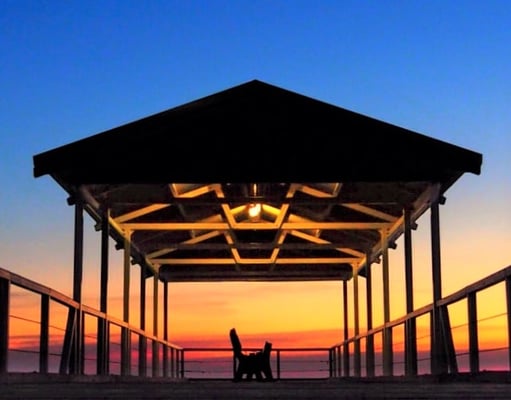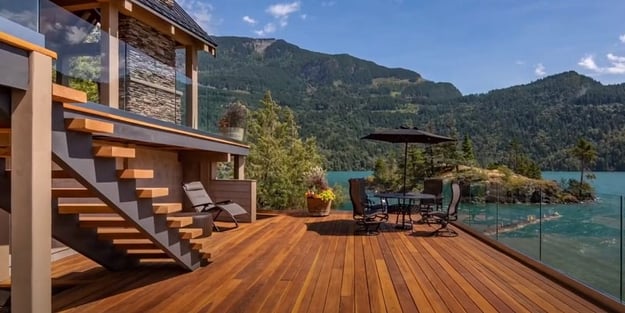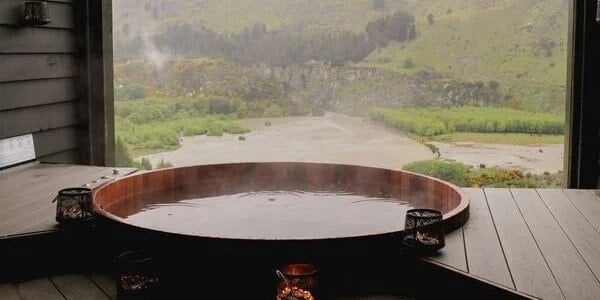
13 Deck Designs with Hot Tubs So Hot They're Cool
Written by Liza Sivek onImagine unwinding in your very own outdoor spa. A well-designed wood hot tub deck can transform your backyard into a serene retreat. In this guide, we'll explore 13 captivating hot tub deck design ideas to inspire your next outdoor project, and the best way to achieve it.
.jpg?width=973&height=649&name=Wood%20deck%20with%20hot%20tubs%20examples%20(5).jpg)
When traveling, I always take advantage of a hot tub out on a rooftop deck or by the pool. The best ones are on natural wood decking which feels so spa-like and comfortable underfoot. That feeling, plus warm bubbles and a soft, fluffy towel nearby makes me feel pampered.
Now I want that same experience at home.
Why Choose a Wood Deck for Your Hot Tub?
To get this same spa feel from a wood deck, look to the inspiration. Spa flooring is popularly made with natural wood.
However, not all wood decking is created equal. Choosing the right wood species is crucial for ensuring the longevity and safety of your deck. After you check out these deck ideas, check out the pro tips I've included on choosing the best wood decking that's both moisture resistant and low maintenance.
Here Are My Thirteen Favorite Hot Tub Deck Ideas:
1. A Gazebo or Pergola for A Luxurious Space
Create a spa-like escape by placing your hot tub under a gazebo or pergola. This provides privacy, shade, protection from the elements, and a touch of elegance. A gazebo that's open-sided lets you take advantage of a spectacular view.
.jpg?width=973&height=649&name=Wood%20deck%20with%20hot%20tubs%20examples%20(7).jpg)
Wood gazebos can be a long lasting, easy upkeep design element over your steamy hot tub area - choose moisture resistant wood decking like hardwoods or thermally modified Hem-Fir.
2. A Wood Deck and Pavilion for a Serene Ambiance
A larger, more solid presence than a gazebo, a pavilion combined with a wood deck create a harmonious outdoor room. The natural beauty of the wood and stone accents here complements the surrounding environment.
.jpg?width=973&height=649&name=Wood%20deck%20with%20hot%20tubs%20examples%20(2).jpg)
A hot tub surrounded by an Ipe wood hot tub deck and stone hardscaping coordinates with the wood shingled exterior of the pavilion.
3. A Pretty Pergola for A Small Space
Even if you have limited space for deck, a pergola and steps can elevate your hot tub area. It create a focal point and provides shade.
.jpg?width=973&height=649&name=Wood%20deck%20with%20hot%20tubs%20examples%20(1).jpg)
Hardwoods, with their durable, naturally insect resistant characteristics, are especially suited to pergolas.
Get your 150+ Deck Designs eBook Now
4. A Compact Spot by the Pool
A hot tub by the pool is a perfect addition to your outdoor oasis. A wood deck can provide a seamless transition between the two areas.

A virtual image of a design that puts the hot tub near the pool with matching wood steps and bench.
5. A Blend of Wood and Stone
Combine wood decking with stone pavers for a visually appealing contrast. This design can create a sophisticated and modern look.
.jpg?width=973&height=649&name=Wood%20deck%20with%20hot%20tubs%20examples%20(8).jpg)
Jatoba (Brazilian Cherry) can give you the warm and elegant reddish-brown tones for a pool deck
6. A Hot Tub with Custom Steps
Elevate your hot tub and enjoy stunning views by adding custom steps and a platform. This design element adds a touch of luxury and functionality.

Thermally modified wood decking is beautiful on this large deck with a raised hot tub
7. An All-Season Retreat
Design your hot tub deck to enjoy year-round. Choose materials that are durable and slip-resistant, even in cold weather.
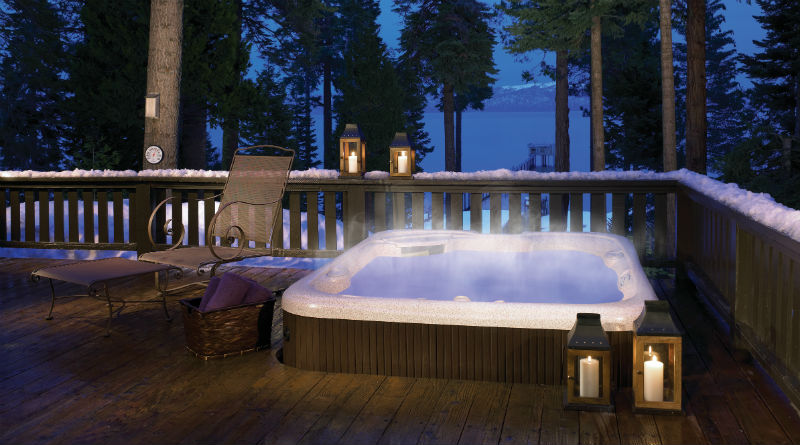
Real hardwood and thermally modified wood decking both shine in harsh climates
8. A Raised Deck for Small Spaces
Maximize your space by building a raised deck. This can create a separate area for your hot tub and other outdoor activities.
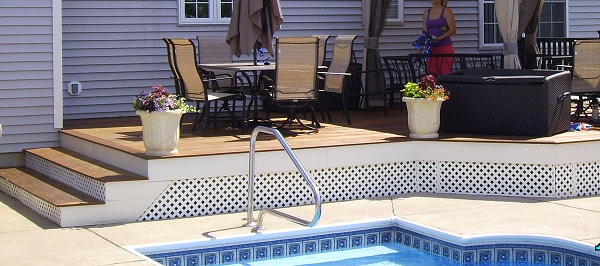
Efficiently use a raised deck to hide uneven ground and make it useful space for a hot tub and dining.
Download the 60+ page eBook for more deck design ideas here
9. Multi-Level Deck for Versatility
A multi-level deck can add visual interest and create distinct zones for different activities, including your hot tub. Matching built in seating and railings give it a custom look.
.jpg?width=973&height=649&name=Wood%20deck%20with%20hot%20tubs%20examples%20(3).jpg)
ThermaWood Hem-Fir is a stronger and more insect resistant decking than non-modified softwoods.
10. All-Wood Deck Surround for a Luxurious Nook
Surround your hot tub with a wood deck for a cohesive and organic look. Consider adding small levels or steps as shown to create a unique design.
.jpg?width=600&height=400&name=Wood%20deck%20with%20hot%20tubs%20examples%20(5).jpg)
Chocolate-brown toned Machiche wood can create this luxurious corner oasis
11. A Walled Nook for Privacy
Is your space in close quarters with neighbors? Want more protection from the weather all year? Create an intimate space for your hot tub deck by enclosing it with permanent walls. This can provide both privacy and shelter from the elements.
.jpg?width=973&height=649&name=Wood%20deck%20with%20hot%20tubs%20examples%20(6).jpg)
High density Ipe wood decking is ideal for a humid environment like an enclosed hot tub
12. Privacy Screening for a Serene Escape
Add privacy screening to your hot tub area using the same decking wood as screening or arbors. This can create a tranquil and secluded space.
.jpg?width=400&height=603&name=Wood%20deck%20with%20hot%20tubs%20examples%20(10).jpg)
ThermaWood Hem-Fir is durable but easy to work with to create design elements
13. A Rustic Touch
Incorporate rustic elements into your hot tub deck design, such as contrasting real wood with field stone accents and using wood decking on the walls.
.jpg?width=600&height=400&name=Wood%20deck%20with%20hot%20tubs%20examples%20(12).jpg)
Choose hardwood with an interesting grain pattern or ThermaWood Hem-Fir with its heat-darkened tones
RELATED: Get the The Ultimate Guide To Selecting The Right Wood Decking here
Choosing The Right Decking For Hot Tub Decks
When selecting real wood decking for your hot tub deck, high density hardwoods and thermally modified Hem-Fir are top performing options. Consider the following factors when deciding on your decking:
Durability: Choose a wood species that is very resistant to moisture, rot, decay, scratching, and insect damage.
Weather Resistance: Choose wood that can withstand harsh weather conditions in your locale, including rain, snow, high UV, and extreme temperatures.
Splinter-resistance: Ensure your decking choice is safe from splintering over time and avoid injury to bare feet
Aesthetics: Select a wood that complements your overall design style. There are many Mataverde wood decking types to choose from so you can find your ideal match.
Sustainable: Choose wood decking that is responsibly sourced, certified sustainably harvested, and can be recycled safely at the end of its lifecycle. Mataverde demands environmentally friendly lumber sourcing and all of our wood decking is sustainable and recyclable.
Hardwood Decking
Hardwood decking is an ideal choice for hot tub decks due to its excellent natural resistance to moisture. This significantly lowers your risk of rot, mold, and mildew on your decking without requiring waterproofing and extra maintenance. It also is naturally resistant to splintering.
High density hardwood decking is very low maintenance. Clean regularly when needed. Apply a UV-resistant oil-based sealant made to penetrate hardwood to prevent weathering and fading and keep the color like new and reapply as needed. (We like and use the Penofin brand in our distribution centers.) Or let it weather naturally to a silver-gray patina and the maintenance lowers to just cleaning, without losing strength.
Some popular Mataverde hardwood options include:
Ipe
Known for its exceptional hardness and durability, Ipe wood has a natural color range of medium to darker brown

Jatoba
Also known as Brazilian Cherry, Jatoba offers a beautiful reddish-brown color range and interesting grain patterns. Jatoba starts out with light pinkish tones and darkens with exposure to UV.

Garapa
A versatile hardwood with a golden blonde color range that lends itself to modern architecture.

FSC© Machiche
Forest Stewardship Certified Machiche has dark chocolate-brown tones.

Cumaru
A durable hardwood with a striking medium-brown color.

RELATED: See the Wood Decking Galleries for more project photos
Thermally Modified Wood Decking
ThermaWood™ Hem-Fir is a sustainable and durable option for hot tub decks at a lower project price than exotic hardwoods. Hem-Fir wood is treated with a patented, non-toxic process utilizing heat and steam. This naturally hardens the wood and removes the natural sugars, creating significantly better resistance to decay and insects than its unmodified counterpart. Mataverde thermally modified decking has very good resistance to moisture damage.
ThermaWood Hem-Fir decking can be painted, stained, or left natural. It can even be weathered. The maintenance is low and includes cleaning and reapplying any finish as needed.
Popular thermally modified wood species from Mataverde include:
ThermaWood Hem-Fir: Offers excellent durability and resistance to decay. The colors are heat deepened during modification leaving a rich range of light to medium brown tones.
ThermaWood FR Hem-Fir: All the advantages of ThermaWood Hem-Fir plus innovative WUI-Approved fire retardant treatment for wildfire-prone areas
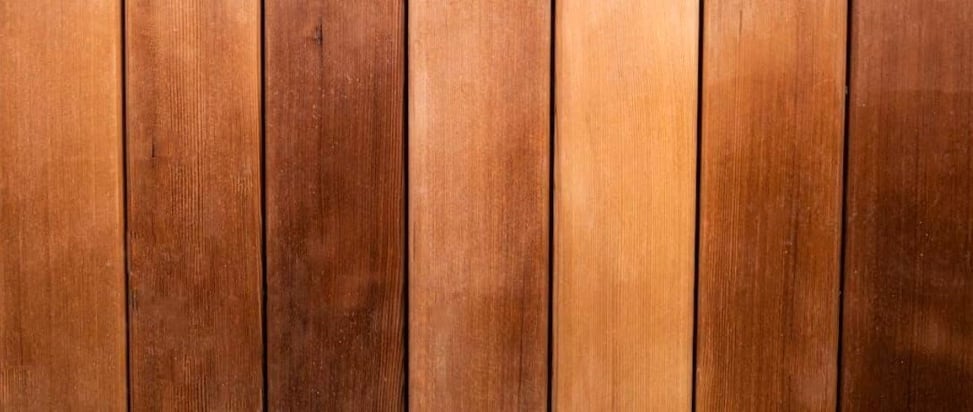
By carefully considering these design ideas and material choices, you can create a stunning and functional hot tub deck that will enhance your outdoor living experience and help you enjoy your hot tub for years.
I hope my ideas inspire you! Feel free to share this article. If you have decking questions, please contact us, we are happy to help.

Related Posts
